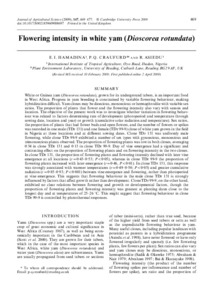| dc.contributor.author | Hamadina, E.I. |
| dc.contributor.author | Craufurd, Peter Q. |
| dc.contributor.author | Asiedu, Robert |
| dc.date.accessioned | 2019-12-04T11:11:38Z |
| dc.date.available | 2019-12-04T11:11:38Z |
| dc.date.issued | 2009 |
| dc.identifier.citation | Hamadina, E.I., Craufurd, P.Q. & Asiedu, R. (2009). Flowering intensity in white yam (Dioscorea rotundata). Journal of Agricultural Science, 147(4), 469-477. |
| dc.identifier.issn | 0021-8596 |
| dc.identifier.uri | https://hdl.handle.net/20.500.12478/2469 |
| dc.description | Published online: 01 April 2009 |
| dc.description.abstract | White or Guinea yam (Dioscorea rotundata), grown for its underground tubers, is an important food in West Africa. Progress in yam breeding is constrained by variable flowering behaviour, making hybridization difficult. Yam clones may be dioecious, monoecious or hermaphrodite with variable sex ratios. The proportion of plants that flower and the flowering intensity also vary with season and location. The objective of the present work was to investigate whether variation in flowering behaviour was related to factors determining rate of development (photoperiod and temperature through sowing date, location and year) or growth (cumulative solar radiation and temperature). Sex ratios, the proportion of plants that had flower buds and open flowers, and the number of flowers or spikes was recorded in one male (TDr 131) and one female (TDr 99-9) clone of white yam grown in the field in Nigeria at three locations and at different sowing dates. Clone TDr 131 was uniformly male flowering, while clone TDr 99-9 exhibited a number of sex types with gynoecious, monoecious and trimonoecious plants observed. The proportion of flowering plants was low in both clones, averaging 0·34 in clone TDr 131 and 0·13 in clone TDr 99-9. Day of vine emergence had a significant and contrasting effect on the proportion of flowering plants and on flowering intensity in the two clones. In clone TDr 131, the proportion of flowering plants and flowering intensity declined with later vine emergence at all locations (r=0·43–0·53; P<0·05), whereas in clone TDr 99-9 the proportion of flowering plants increased with later emergence (r=0·46, P<0·01). In clone TDr 131, this response was strongly associated with warmer temperatures (r=0·49–0·50; P<0·05) and greater cumulative radiation (r=0·85–0·93; P<0·001) between vine emergence and flowering, rather than photoperiod at vine emergence. This suggests that flowering behaviour in the male clone TDr 131 is strongly influenced by factors that affect growth rather than development. Clone TDr 99-9, on the other hand, exhibited no clear relations between flowering and growth or developmental factors, though the proportion of flowering plants and flowering intensity was greatest at planting dates close to the longest day and at temperatures of 25–26°C. This might suggest that flowering behaviour in clone TDr 99-9 is controlled by photothermal responses. |
| dc.format.extent | 469–477 |
| dc.language.iso | en |
| dc.subject | Yams |
| dc.subject | Yam Breeding |
| dc.subject | Flowering |
| dc.subject | Soil Fertility |
| dc.subject | Flowers |
| dc.title | Flowering intensity in white yam (Dioscorea rotundata) |
| dc.type | Journal Article |
| dc.description.version | Peer Review |
| cg.contributor.affiliation | International Institute of Tropical Agriculture |
| cg.contributor.affiliation | University of Reading |
| cg.coverage.region | Africa |
| cg.coverage.region | West Africa |
| cg.coverage.country | Nigeria |
| cg.isijournal | ISI Journal |
| cg.authorship.types | CGIAR and advanced research institute |
| cg.iitasubject | Yam |
| cg.iitasubject | Plant Breeding |
| cg.iitasubject | Soil Fertility |
| cg.iitasubject | Genetic Improvement |
| cg.journal | Journal of Agricultural Science |
| cg.howpublished | Formally Published |
| cg.accessibilitystatus | Limited Access |
| local.dspaceid | 93220 |
| cg.identifier.doi | https://dx.doi.org/10.1017/S0021859609008697 |

